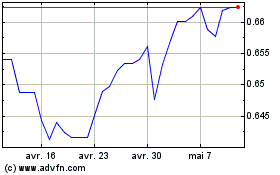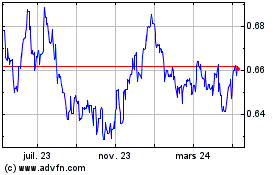Dollar At Multi-day Low Vs Franc After Disappointing U.S. Retail Sales Data
01 Avril 2019 - 11:53AM
RTTF2
The U.S. dollar declined to a multi-day low against the Swiss
franc in the European session on Monday, following a data showing a
modest decrease in U.S. retail sales for February.
Data from the Commerce Department showed that retail sales
dipped by 0.2 percent in February after climbing by an upwardly
revised 0.7 percent in January.
Economists had expected sales to rise by 0.3 percent compared to
the 0.2 percent uptick originally reported for the previous
month.
Excluding a rebound in sales by motor vehicle and parts dealers,
retail sales fell by 0.4 percent in February after jumping by a
revised 1.4 percent in January.
Ex-auto sales had been expected to climb by 0.4 percent compared
to the 0.9 percent increase originally reported for the previous
month.
Investors awaited high-level trade talks between the world's two
largest economies after Washington remarked that the negotiations
were "candid and constructive."
Beijing announced that it would continue to suspend additional
tariffs on U.S. vehicles and auto parts after April 1 as a gesture
after Washington delayed tariff hikes on Chinese imports.
The greenback showed mixed trading against its major
counterparts in the Asian session. While it fell against the euro
and the pound, it held steady against the franc. Against the yen,
it rose.
The greenback that closed Friday's trading at 0.9951 against the
franc fell to a 5-day low of 0.9931. Continuation of the
greenback's downtrend may take it to a support around the 0.98
mark.
Data from the Federal Statistical Office showed that
Switzerland's retail sales fell for the fourth consecutive month in
February.
Retail sales fell a calendar-adjusted 0.2 percent year-on-year
in February, same as in January. In December, retail sales declined
0.5 percent.
The greenback edged down to 110.81 against the yen, from an
early near a 2-week high of 111.19. The greenback is seen
challenging support around the 108.00 region.
The U.S. currency remained lower at 1.3113 against the pound,
down from last week's closing value of 1.3034. On the downside,
1.33 is likely seen as the next support for the greenback.
Survey data from IHS Markit showed that UK manufacturing sector
grew at the fastest pace in over a year in March, as stockpiling by
businesses hit a record as they braced for Brexit disruptions.
The CIPS purchasing managers' index, or PMI, for the
manufacturing sector climbed to a 13-month high of 55.1 from 52.1
in February. Economists had forecast a score of 51.2.
The greenback fell back to 1.1247 against the euro, not far from
a 4-day low of 1.1250 touched at 4:30 am ET. Next key support for
the greenback is likely seen around the 1.14 region.
Preliminary data from the statistical office Eurostat showed
that Eurozone inflation slowed in March, defying expectations for
stability, while the unemployment rate remained unchanged in
February.
Headline inflation slowed to 1.4 percent from 1.5 percent in
February. Economists had expected the inflation rate to remain
unchanged.
The greenback retreated to 0.6836 against the kiwi, a pip short
of a 5-day low of 0.6837 seen at 1:45 am ET. If the greenback
declines further, 0.70 is likely seen as its next support
level.
The greenback pulled back to 0.7129 against the aussie, just few
pips short of a 5-day low of 0.7132 hit at 3:30 am ET. The
greenback is poised to find support around the 0.73 region.
The greenback slipped to 1.3337 against the loonie, its lowest
since March 21. This follows a high of 1.3370 set at 8:30 am ET.
The greenback is likely to challenge support around the 1.31
level.
The U.S. ISM manufacturing index for March, construction
spending for February and business inventories for January are
scheduled for release shortly.
AUD vs US Dollar (FX:AUDUSD)
Graphique Historique de la Devise
De Mar 2024 à Avr 2024

AUD vs US Dollar (FX:AUDUSD)
Graphique Historique de la Devise
De Avr 2023 à Avr 2024
